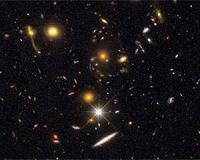 |
Washington DC (SPX) Jan 06, 2010 NASA's Spitzer Space Telescope has captured an action-packed picture of the nearby Small Magellanic Cloud, a small galaxy that looks like a wispy cloud when seen from Earth. From Spitzer's perch up in space, the galaxy's clouds of dust and stars come into clear view. The telescope's infrared vision reveals choppy piles of recycled stardust - dust that is being soaked up by new star systems and blown out by old ones. To some people, the new view might resemble a sea creature, or even a Rorschach inkblot test. But to astronomers, it offers a unique opportunity to study the whole life cycle of stars close-up. The image is available online at: "It's quite the treasure trove," said Karl Gordon, the principal investigator of the latest Spitzer observations at the Space Telescope Science Institute in Baltimore, Md. "Because this galaxy is so close and relatively large, we can study all the various stages and facets of how stars form in one environment." The Small Magellanic Cloud, and its larger sister galaxy, the Large Magellanic Cloud, are named after the seafaring explorer Ferdinand Magellan, who documented them while circling the globe nearly 500 years ago. From Earth's southern hemisphere, they can appear as wispy clouds. The Small Magellanic Cloud is the farther of the pair, at 200,000 light-years away. Recent research has shown that the galaxies may not, as previously suspected, orbit around the Milky Way. Instead, they are thought to be merely sailing by, destined to go their own way. Astronomers say the two galaxies, which are both less evolved than a galaxy like ours, were triggered to create bursts of new stars by gravitational interactions with the Milky Way and with each other. In fact, the Large Magellanic Cloud may eventually consume its smaller companion. Gordon and his team are interested in the Small Magellanic Cloud not only because it is so close and compact, but also because it is very similar to young galaxies thought to populate the universe billions of years ago. The Small Magellanic Cloud has only one-fifth the amount of heavier elements, such as carbon, contained in the Milky Way, which means that its stars haven't been around long enough to pump large amounts of these elements back into their environment. Such elements were necessary for life to form in our solar system. Studies of the Small Magellanic Cloud therefore offer a glimpse into the different types of environments in which stars form. The new Spitzer observations were presented today at the 215th meeting of the American Astronomical Meeting in Washington, DC. They reveal the galaxy's youngest stars embedded in thick dust, in addition to the older stars, which spit the dust out. Taken together with visible-light observations, these Spitzer data help provide a census of the whole stellar population. "With Spitzer, we are pinpointing how to best calculate the numbers of new stars that are forming right now," said Gordon. "Observations in the infrared give us a view into the birthplace of stars, unveiling the dust-enshrouded locations where stars have just formed." Infrared light is color-coded in the new picture, so that blue shows older stars, green shows organic dust and red highlights dust-enshrouded star formation. Light encoded in blue has a wavelength of 3.6 microns; green is 8.0 microns; and red is 24 microns. This image was taken before Spitzer ran out of its liquid coolant in May 2009 and began its "warm" mission. Other collaborators include: M. Meixner, M, Sewilo and B. Shiao of the Space Telescope Science Institute; M. Meade, B. Babler, S. Bracker of the University of Wisconsin at Madison; C. Engelbracht, M. Block, K. Misselt of the University of Arizona, Tucson; R. Indebetouw of the University of Virginia, Charlottesville; and J. Hora and T. Robitaille of the Harvard Smithsonian Center for Astrophysics, Cambridge, Mass. The image includes Spitzer observations taken previously by a team led by Alberto Bolatto of the University of Maryland, College Park.
Share This Article With Planet Earth
Related Links Spitzer at Caltech Spitzer at NASA Stellar Chemistry, The Universe And All Within It
 Galaxy History Revealed In Colorful Hubble View
Galaxy History Revealed In Colorful Hubble ViewWashington DC (SPX) Jan 06, 2010 More than 12 billion years of cosmic history are shown in an unprecedented, panoramic, full-color view of thousands of galaxies in various stages of assembly. This image, taken by NASA's Hubble Space Telescope, was made from mosaics taken in September and October 2009 with the newly installed Wide Field Camera 3 (WFC3) and in 2004 with the Advanced Camera for Surveys (ACS). The view covers ... read more |
|
| The content herein, unless otherwise known to be public domain, are Copyright 1995-2009 - SpaceDaily. AFP and UPI Wire Stories are copyright Agence France-Presse and United Press International. ESA Portal Reports are copyright European Space Agency. All NASA sourced material is public domain. Additional copyrights may apply in whole or part to other bona fide parties. Advertising does not imply endorsement,agreement or approval of any opinions, statements or information provided by SpaceDaily on any Web page published or hosted by SpaceDaily. Privacy Statement |